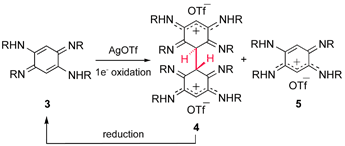One-electron oxidation-induced dimerising C–C coupling of a 2,5-diamino-1,4-benzoquinonediimine: a chemical and electrochemical investigation†
Abstract
The one-electron

* Corresponding authors
a
Laboratoire de Chimie de Coordination (UMR 7513 CNRS), Université Louis Pasteur, 4, rue Blaise Pascal, Strasbourg cedex, France
E-mail:
braunst@chimie.u-strasbg.fr
b Laboratoire de Chimie Organo-Minérale (UMR 7513 CNRS), Université Louis Pasteur, 4, rue Blaise Pascal, Strasbourg cedex, France
The one-electron

 Please wait while we load your content...
Something went wrong. Try again?
Please wait while we load your content...
Something went wrong. Try again?
J. Taquet, O. Siri, J. Collin, A. Messaoudi and P. Braunstein, New J. Chem., 2005, 29, 188 DOI: 10.1039/B408762C
To request permission to reproduce material from this article, please go to the Copyright Clearance Center request page.
If you are an author contributing to an RSC publication, you do not need to request permission provided correct acknowledgement is given.
If you are the author of this article, you do not need to request permission to reproduce figures and diagrams provided correct acknowledgement is given. If you want to reproduce the whole article in a third-party publication (excluding your thesis/dissertation for which permission is not required) please go to the Copyright Clearance Center request page.
Read more about how to correctly acknowledge RSC content.
 Fetching data from CrossRef.
Fetching data from CrossRef.
This may take some time to load.
Loading related content
